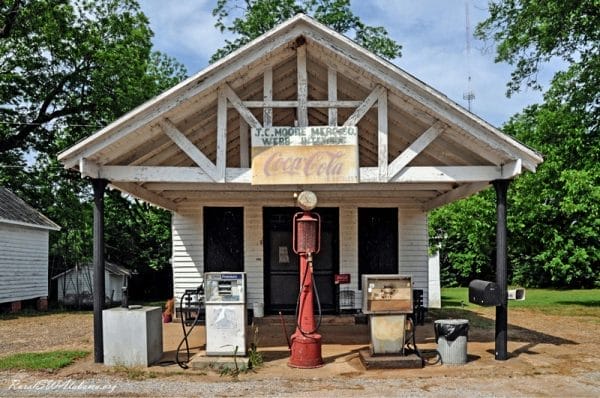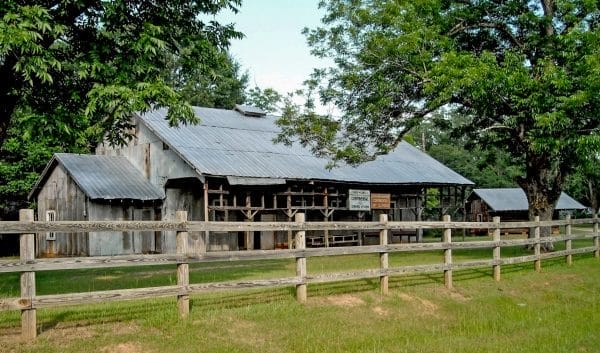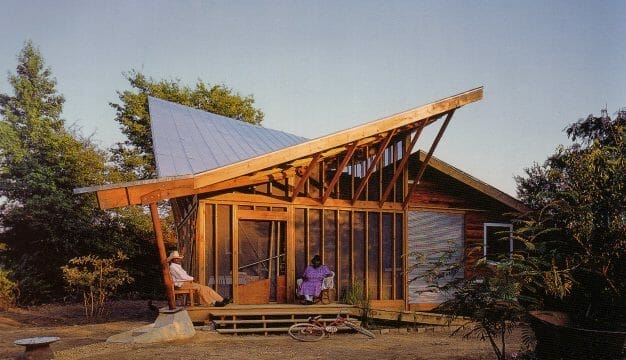Moore-Webb-Holmes Plantation
The Moore-Webb-Holmes Plantation in Folsom, Perry County, is one of the oldest continuous working family farms in Alabama. Originally founded in 1819 by William Moore, the 80-acre property on which the plantation originally stood expanded over the years to eventually encompass as many as 20,000 acres. Though the main house burned to the ground in 1927, the plantation still includes a large number of agricultural buildings that visitors may tour by appointment.
 Moore-Webb-Holmes Plantation
In 1819, William Moore, a wagon maker from the Newberry District of South Carolina, moved to present-day Perry County in the Alabama Territory and established a homestead on 80 acres of land. He initially lived in a small dog-trot home that he built. By 1837, the plantation expanded to almost 680 acres thanks to newly opened federal lands, and by 1860 it would encompass nearly 2,000 acres and be worked by some 30 to 40 enslaved laborers. With the conclusion of the American Civil War and the adoption of the Thirteenth Amendment abolishing slavery, the newly emancipated workers on the Moore Plantation transitioned to a system of tenancy and sharecropping and continued cultivating cotton, and the property expanded to about 5,000 acres. William Moore’s son John Calhoun Moore took over the property and expanded the plantation to almost 20,000 acres. It had become so large that by 1875 Moore opened a store on the property that likely served as the plantation commissary for the tenant farmers. By 1887, a post office was added to the commissary building to serve the ever-increasing population of the Moore Plantation. The post office closed in 1904.
Moore-Webb-Holmes Plantation
In 1819, William Moore, a wagon maker from the Newberry District of South Carolina, moved to present-day Perry County in the Alabama Territory and established a homestead on 80 acres of land. He initially lived in a small dog-trot home that he built. By 1837, the plantation expanded to almost 680 acres thanks to newly opened federal lands, and by 1860 it would encompass nearly 2,000 acres and be worked by some 30 to 40 enslaved laborers. With the conclusion of the American Civil War and the adoption of the Thirteenth Amendment abolishing slavery, the newly emancipated workers on the Moore Plantation transitioned to a system of tenancy and sharecropping and continued cultivating cotton, and the property expanded to about 5,000 acres. William Moore’s son John Calhoun Moore took over the property and expanded the plantation to almost 20,000 acres. It had become so large that by 1875 Moore opened a store on the property that likely served as the plantation commissary for the tenant farmers. By 1887, a post office was added to the commissary building to serve the ever-increasing population of the Moore Plantation. The post office closed in 1904.
In 1914, the devastation to cotton agriculture caused by the boll weevil prompted a transition towards greater crop diversification as well as harvesting timber and raising cattle; a move accelerated by wartime needs in the wake of America’s entry into World War I. In 1927, the main plantation home burned down, and the Moore family moved to a nearby home called “Magnolia Hill” in Marion that was remodeled and enlarged. Many of the furnishings from the original home were rescued from the fire and placed in the new home. Meanwhile, the transition towards more varied land use continued throughout the 1930s and 1940s under the fourth generation of the Moore family, who created the predominant architectural landscape seen today. Most likely during this period, the scattered tenant houses and the old slave quarters from the pre-1900 period were either lost to nature or demolished.
 Cotton Seed Barn
Presently, the property showcases many period agricultural buildings that include a log seed house that was used with the property’s first cotton gin, a smoke house, a gristmill, a general store, a chicken coop, a blacksmith shop, tenant quarters, a fire house, and more. Artifacts on the property include historic papers, a deed signed by Andrew Jackson, and farm equipment such as wagons, plows, and hay rakes. The oldest structure still standing on the Moore-Webb-Holmes Plantation is the two-story I-house of William Moore’s nearby neighbor, John Hogue. The home was constructed in 1835 and absorbed into the Moore plantation in 1897. It is currently owned by Charles A. Holmes, a fifth-generation descendant of William Moore. Holmes manages the home and the plantation with his wife Jenny Cooper Holmes under the Holmestead Company.
Cotton Seed Barn
Presently, the property showcases many period agricultural buildings that include a log seed house that was used with the property’s first cotton gin, a smoke house, a gristmill, a general store, a chicken coop, a blacksmith shop, tenant quarters, a fire house, and more. Artifacts on the property include historic papers, a deed signed by Andrew Jackson, and farm equipment such as wagons, plows, and hay rakes. The oldest structure still standing on the Moore-Webb-Holmes Plantation is the two-story I-house of William Moore’s nearby neighbor, John Hogue. The home was constructed in 1835 and absorbed into the Moore plantation in 1897. It is currently owned by Charles A. Holmes, a fifth-generation descendant of William Moore. Holmes manages the home and the plantation with his wife Jenny Cooper Holmes under the Holmestead Company.
The Holmestead Company has recently devoted itself to raising grass-fed beef, organic farming, and becoming ecologically self-sustaining. The plantation currently encompasses almost 6,000 acres of land of which 4,000 acres constitute a sustainable forest that primarily consists of loblolly and longleaf pines. The forest is a certified TREASURE Forest by the Alabama TREASURE Forest Association for the Holmes’s dedication to sustainable and multiuse forest land management. On August 24, 2011, the Moore-Webb-Holmes Plantation was added to the National Register of Historic Places. The Alabama Department of Agriculture and Industries recognized the plantation an Alabama Century and Heritage Farm in 1977 by for being continuously run as a family farm larger than 40 acres for more than 100 years and for its historical significance.
 Cotton Ginning Barn
Moore-Webb-Holmes Plantation is located on Highway 14 about seven miles west of Marion. It is open to the public for tours by appointment and also offers full day or two-day guided tours of Alabama’s Black Belt that include a historical architecture tour of Marion and antebellum home tours of Greensboro, Demopolis, and Eutaw. Visitors may also spend the night in the former overseers’ cottage, called the “Folsom Inn.” Additionally, every year on the first Saturday in October, the Moore-Webb-Holmes Plantation hosts the “Fall in Folsom” event, which provides a day of history and entertainment featuring music, hay rides, a corn maze, and pumpkin picking.
Cotton Ginning Barn
Moore-Webb-Holmes Plantation is located on Highway 14 about seven miles west of Marion. It is open to the public for tours by appointment and also offers full day or two-day guided tours of Alabama’s Black Belt that include a historical architecture tour of Marion and antebellum home tours of Greensboro, Demopolis, and Eutaw. Visitors may also spend the night in the former overseers’ cottage, called the “Folsom Inn.” Additionally, every year on the first Saturday in October, the Moore-Webb-Holmes Plantation hosts the “Fall in Folsom” event, which provides a day of history and entertainment featuring music, hay rides, a corn maze, and pumpkin picking.
Nearby is the Marion Military Institute and in Greensboro are the antebellum plantation house Magnolia Grove, the birthplace of Richmond Hobson Pearson, the Noel-Ramsey House built by members of the Vine and Olive Colony, and the Greensboro Opera House.



